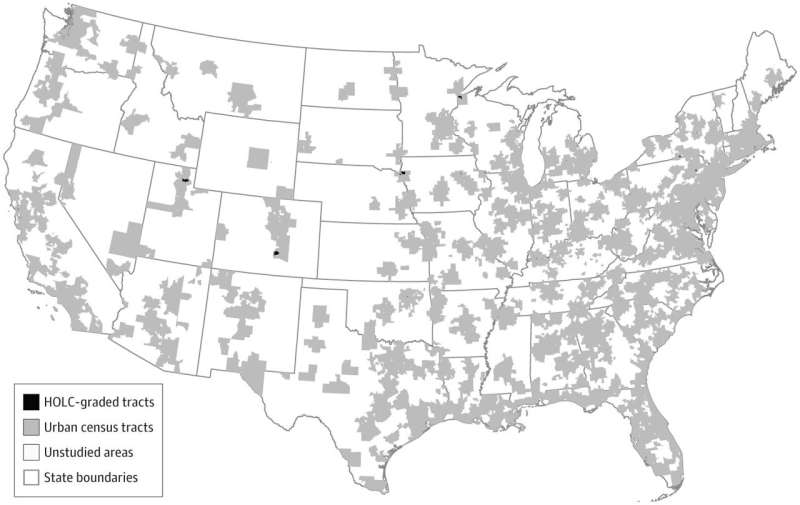Across the US, White neighborhoods have more greenery, fewer dilapidated buildings, fewer multi-family homes: Study

Historic redlining and other racist policies have led to present-day racial and economic segregation and disinvestment in many cities across the United States. Research has shown how neighborhood characteristics and resources are associated with health disparities such as preterm birth and asthma, but most of these studies are limited in scale and overlook many aspects in a neighborhood that are difficult to measure, including dilapidated buildings and crosswalks.
Now, a new study led by Boston University School of Public Health (BUSPH) and the Center for Antiracist Research (CAR) at Boston University (BU) has utilized panorama digital technology through Google Street View (GSV) to identify these neighborhood characteristics on a national scale and shed light on how they contribute to racial and ethnic disparities in local resources and health outcomes across the US.
Published in the journal JAMA Network Open, the study found that predominantly White neighborhoods had better neighborhood conditions generally associated with good health, such as fewer neglected buildings and multi-family homes, and more greenery than neighborhoods with residents who were primarily Black, of other minority races, or of a variety of races and ethnicities.
The findings underscore the need for comprehensive and accessible data platforms that researchers can utilize to better understand the role of the built environment on racial and health inequities, and inform policies that aim to create equitable neighborhood resources in all communities.
“Large datasets on determinants of health can help us better understand the associations between past and present policies—including racist and antiracist policies—and neighborhood health outcomes,” says study corresponding author Dr. Elaine Nsoesie, associate professor of global health at BUSPH. “Neighborhood images are one dataset that have the potential to enable us to track how neighborhoods are changing, how policies are impacting these changes and the inequities that exist between neighborhoods.”
For the study, Dr. Nsoesie and colleagues analyzed national data on race, ethnicity, socioeconomics, and health outcomes, and 164 million GSV images across nearly 60,000 US census tracts. The team examined five neighborhood characteristics: dilapidated buildings, green spaces, crosswalks, multi-family homes, and single-lane roads.
The largest disparities in neighborhood environments were reflected in green space and non-single family homes. Compared to predominantly White neighborhoods, predominantly Black neighborhoods had 2 percent less green space, and neighborhoods with racial minorities other than Black had 11 percent less green space.
Compared to White neighborhoods, neighborhoods with racial minorities other than Black had 17 percent more multi-family homes, while neighborhoods with Black residents and neighborhoods with residents representing a variety of races and ethnicities had 6 percent and 4 percent more multi-family homes, respectively.
The researchers also conducted modeling to measure how the built environment may influence the association between health outcomes and the racial makeup of neighborhoods, and found the strongest connections between sleeping problems among residents in neighborhoods with racial minorities other than Black or White, and asthma among neighborhoods with residents representing a variety of races and ethnicities.
“An interesting finding from our paper is how a considerable portion of the racial/ethnic differences of the built environment conditions was shown at the state level,” says study co-lead author Yukun Yang, a data scientist at CAR. “This prompts us to think practically about how state and local government and policymakers could and should address the inequitable distribution of built environment resources which could further address the health disparities we observed today.”
“Our findings really demonstrate the path-dependent nature of inequality and racial disparities,” says study co-lead author Ahyoung Cho, a racial data/policy tracker at CAR and a political science Ph.D. student at BU. “It is critical to develop appropriate policies to address structural racism.”
More information:
Yukun Yang et al, Association of Neighborhood Racial and Ethnic Composition and Historical Redlining With Built Environment Indicators Derived From Street View Images in the US, JAMA Network Open (2023). DOI: 10.1001/jamanetworkopen.2022.51201
Citation:
Across the US, White neighborhoods have more greenery, fewer dilapidated buildings, fewer multi-family homes: Study (2023, January 20)
retrieved 21 January 2023
from https://phys.org/news/2023-01-white-neighborhoods-greenery-dilapidated-multi-family.html
This document is subject to copyright. Apart from any fair dealing for the purpose of private study or research, no
part may be reproduced without the written permission. The content is provided for information purposes only.
For all the latest Science News Click Here
For the latest news and updates, follow us on Google News.

